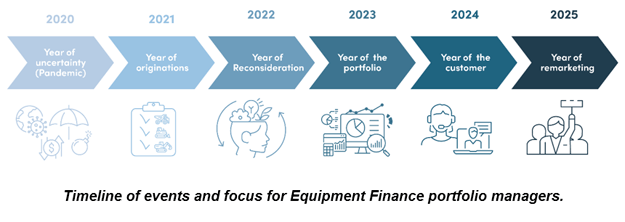
The challenges of early 2020 have come full circle in 2023. The boon of originations over the past 30 months combined with rapidly increasing interest rates and a looming recession have made 2023 the Year of the Portfolio. Delinquencies and the cost of funds are both rising and portfolios are swollen with atypical deals and asset concentrations created by pandemic stimulus. Unbalanced portfolios created by government shutdowns and supply chain disruptions are now the primary source of risk for equipment finance companies in meeting their financial expectations.
So, how did we get here – to the Year of the Portfolio – and how should equipment finance leaders respond and manage their portfolios given the challenges created by these market dynamics?
How Did We Get Here?

The pandemic made 2020 the Year of Uncertainty. In retrospect, the pandemic itself was not as unpredictable as the government response – total economic shutdown followed by massive stimulus. Borrowers in industries like hospitality and food service were immediately devastated by the shutdowns creating problems for the finance companies that had financially supported them. Then came the stimulus – sent in waves in an effort to reboot the economy. Money flooded into both consumer and business accounts alike. Payment uncertainty was quickly transformed into unexpected opportunity as new norms like work-from-home (WFH) and shop-from-home channeled the stimulus into ecommerce and IT products. The stimulus wave cascaded into domestic transportation services which were struggling to deal with the global supply chain and distribution disruption created by closed borders.
2020 delivered on uncertainty creating some big losses but the stimulus created opportunities for big wins in 2021 – the Year of Originations. Originations grew as much as 30 percent year over year and continued double-digit growth in many markets. Work-from-home enabled employees to work from any location creating domestic migration by lifestyle. This migration collided with an existing residential inventory shortage and resulted in a surge in construction demand. At the same time, supply chain disruptions created both headaches and opportunities as used equipment prices – driven by increased demand and lower inventories – increased by as much as 70 percent in some classes. Lessors serving the transportation and yellow iron markets found themselves awash in deal demand but often faced a lack of available equipment.
2022 became the Year of Reconsideration for many business leaders across the economy as the waves of stimulus brought double-digit inflation and the federal government predictably stepped in with the fastest interest rate increases in more than four decades. With the fast-rising prices and increasing borrowing costs, the specter of a recession took hold almost immediately and put a damper on 2022 economic forecasts. Demand for equipment finance remained high, however, as continued economic uncertainty pushed businesses away from CAPEX towards the OpEx models of leasing. But the damage was already done. Confusion set in and, as a result, business leaders reconsidered both strategy and tactics.
How Should We Respond?
As we enter 2023, many lessors now have significantly expanded portfolios packed with new partners, programs, customer relationships, and new asset types. With equipment prices crashing in some markets as supply chains try to catch up and delinquencies rising, portfolios are full of new risks as well as new responsibilities for those managing risk.
So how should portfolio managers respond to the current economic environment? As is often the case, data and analysis tools can be brought to bear to streamline processes and provide business intelligence to help evaluate and make portfolio decisions. Portfolio managers can leverage data in three different ways to ensure that they do not lose the momentum of recent growth to the erosion of portfolio profitability.
Identify and address concentrations to hedge recession risks.
The first step is to identify and address concentrations that may have resulted from unbalanced organizational activities during the stimulus period. Heavy concentrations in certain classes of equipment, for example, can present new risks if the market values of those classes decrease faster than originally expected. Industry concentrations can present portfolio risks if those concentrations are in less recession-proof industries.
If an organization has responded to higher interest rates with more True Leases, the values of assets could compound payment risk with collateral risk. FMV data streams, data streams like Sandhills Value Insight Portal, provide real time market values for used equipment moving through dealer channels and auctions that can be used to analyze existing portfolios as well as help reduce asset value risk on new originations.
Concentrations can be assessed and then balanced through syndication, customer contacts, account early-exit-strategies, and adjusted sales-by-market strategies. Indeed, in this period, portfolio managers will play a key role in helping the organization define its sales strategies for both deal profitability and risk management across the portfolio through hedging. Equifax’s recent Market Pulse illustrated how different industries perform during recessions and unprecedented trends in labor and housing will exacerbate the unevenness of recession impacts. Portfolio managers need to augment their historical recession experiences with live data from this recession to both avoid new risks and find new opportunities.
Identify and get ahead of stressed accounts.
Those accounts stressed by the recession, inflation and higher rates will need near-constant attention. Portfolio managers should expect to contact borrowers earlier in the delinquency process and with more frequent attention. Teams should be trained to recognize material financial challenges from those that are administrative in nature. Predictive tools can help determine which accounts require the most immediate and intense management.
At the start of the year, delinquencies had already risen in some parts of the economy – as inflation impacts the ability of consumers to pay living expenses. Again, economic data sources like Equifax provide insights for analysis within the portfolio. Portfolio data will show changes in payment days as well as delinquency within the existing customer base. Finance companies with DIY borrower portals will get insights from the data of their customers – who is checking future payments, looking at a buyout, or reviewing contracts for potential opportunities.
Customer teams can work with asset managers to secure additional collateral and/or guarantees, adjust terms to the benefit of both lender and borrower, or begin collection to avoid recovery costs.
Focus asset management on interest rate spreads, residuals, and renewals
Asset management will also play a key role in 2023. Smaller lessors often have funding lines with short-term interest rates that are reducing the spread on deals. Combine spread-risk with the rapid ups and downs of used equipment prices and supply chain disruption, and asset managers have a lot to do. They will need to work with portfolio managers to identify their over- exposure in certain asset classes as well as the underperforming assets that require attention at the customer level to extend payment streams, renewals, or syndication to balance overall portfolio performance. And long-term customers can be challenged during recessions, so determining the right approach is the key to maintaining the long-term earning strength of the portfolio.
Where Do We Go Now?
So what comes after a Year of the Portfolio? The surge in originations followed by the economic impact of high inflation and interest rates will stress borrowers, leading to 2024 becoming the Year of the Customer. As portfolio managers funnel lists of stressed accounts and pending contract collections to customer service teams, the volume and intensity of the effort will require help from automation. Customer-centric systems like borrower self-service applications as well as both monitoring and prediction of new delinquency risks will become essential tools for enabling a high volume of transactions and also for facilitating transparency for customers.
Depending upon the depth of the recession and further geopolitical disruption, the following year – 2025 - will likely evolve into the Year of Remarketing as lessors with leases of 36-to-42-month terms will see the surge of equipment returns from 2021 and 2022 deals coming to term. Renewals, recoveries, and end of lease remarketing will be on the mind of executives – particularly if the organization made strong inroads back into True Leasing where residuals often determine the final value of the deal.
Now is the time to evaluate your portfolio management tools and make sure that you can both determine and manage your risk exposure. Business intelligence tools can help you analyze your current portfolios and leverage data to make better, more strategic decisions that maintain financial expectations. The last few years have been unprecedented in both their economic volatility and uncertainty, but now the die has been cast and portfolio managers are front and center. How they respond, adapt, and innovate will define the next group of winners.
